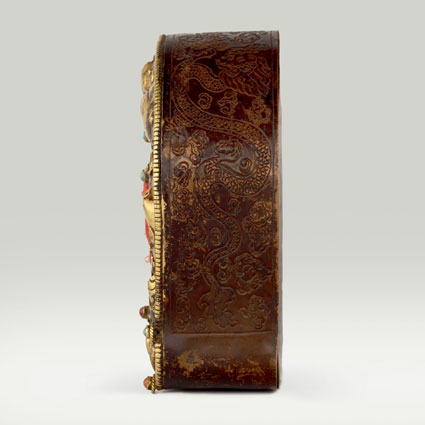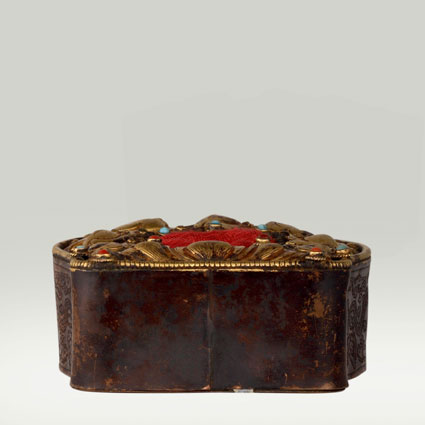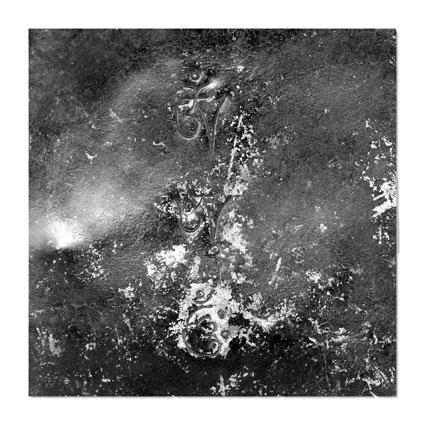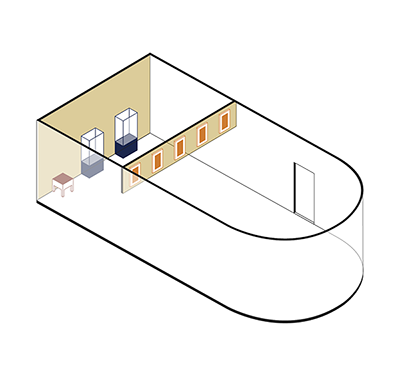ABS 191
Code: ABS 191
Country: Tibet
Style:
Date: 1700 - 1800
Dimensions in cm WxHxD: 8.2 x 12.9 x 4.8
Materials: Gilt copper
Gau
Metal, small shrine altar, portable reliquary, or a container for relics of amuletten for a necklace or in the hair.
A gau may consist of a small statue of a Tibetan deity or a Buddha or similar representations, such as miniature paintings which are called Tibetan Tsakli. The small statues can be made from metal, wood or stone; a clay statuette created called tsatsa using mold.
In a gau may relics such as bone parts, hair, fragments of clothing of deceased teachers, religious text portions of herbs are stored.
Metal, small shrine altar, portable reliquary, or a container for relics of amuletten for a necklace or in the hair.
A gau may consist of a small statue of a Tibetan deity or a Buddha or similar representations, such as miniature paintings which are called Tibetan Tsakli. The small statues can be made from metal, wood or stone; a clay statuette created called tsatsa using mold.
In a gau may relics such as bone parts, hair, fragments of clothing of deceased teachers, religious text portions of herbs are stored.
A Tibetan gau is mostly metal, small shrine altar, portable reliquary, or a container for relics of amuletten for a necklace or in the hair. A gau may consist of a small statue of a Tibetan deity or a Buddha or similar representations, such as miniature paintings which are called Tibetan Tsakli. The small statues can be made from metal, wood or stone; a clay statuette created called tsatsa using molds. The latter can be done by high-vajrayana lamas dedicated, or the clay can be mixed with the axis of a deceased lama. In a gau may relics such as bone parts, hair, fragments of clothing of deceased teachers, religious text portions of herbs are stored. Also, metal amulets called thokcha can be in a gau.
A gau normally consists of two parts and is composed of the nature of the casket. The front is mostly with copper foil, or -silver -gold edited and can be further embellished with jewel stones like corals, turquoise or pearls. It usually carries a representation of a Buddha or Buddhist deity symbol of luck and exhibits at the larger ones in the middle window. The back is usually made of copper and may have inscriptions of religious symbols. Larger specimens are rectangular and the upper portion generally arcing protrudes upwards, while the smaller ones square, polygonal or round and are worn on a necklace, or with a buckle in the hair. The larger, portable gau is used on the altar. Even nomads tend to have the portable gau, but they are also on the tabernacle altar. The portable ones are worn with a fabric or leather strap over the shoulder so that they hang on the side or behind the body. This way of wearing the gau is especially much smaller in use during bedevaarten. De copies can be continuously worn on the neck or in the hair. They are made of precious materials and are worn during holidays.
(https://www.timmersgems.com/en/tibetan-travel-altar-called-gau-about-13-x-16-cm.html)
A gau normally consists of two parts and is composed of the nature of the casket. The front is mostly with copper foil, or -silver -gold edited and can be further embellished with jewel stones like corals, turquoise or pearls. It usually carries a representation of a Buddha or Buddhist deity symbol of luck and exhibits at the larger ones in the middle window. The back is usually made of copper and may have inscriptions of religious symbols. Larger specimens are rectangular and the upper portion generally arcing protrudes upwards, while the smaller ones square, polygonal or round and are worn on a necklace, or with a buckle in the hair. The larger, portable gau is used on the altar. Even nomads tend to have the portable gau, but they are also on the tabernacle altar. The portable ones are worn with a fabric or leather strap over the shoulder so that they hang on the side or behind the body. This way of wearing the gau is especially much smaller in use during bedevaarten. De copies can be continuously worn on the neck or in the hair. They are made of precious materials and are worn during holidays.
(https://www.timmersgems.com/en/tibetan-travel-altar-called-gau-about-13-x-16-cm.html)
Beer, Robert , 2003. Les symboles du bouddhisme Tibétain. Albin Michel. Pp. 307-309







